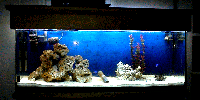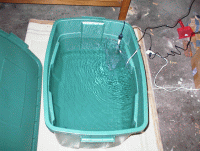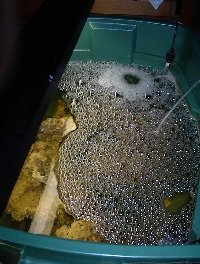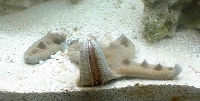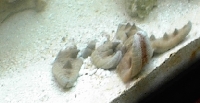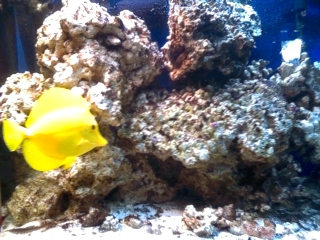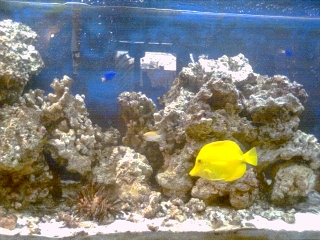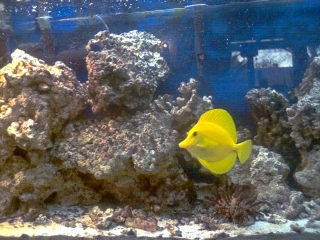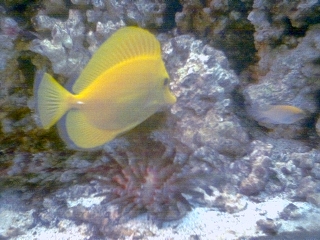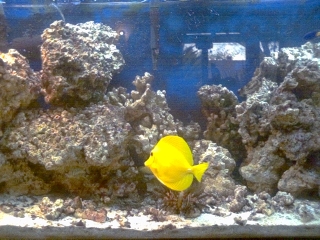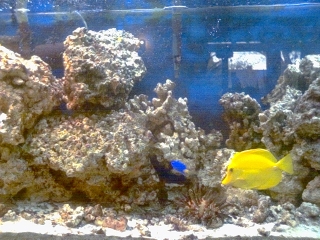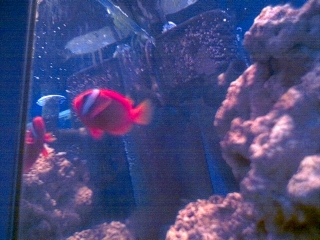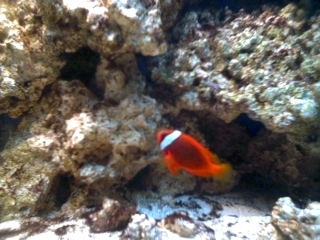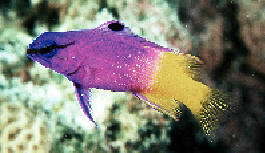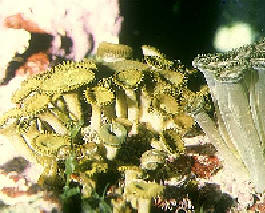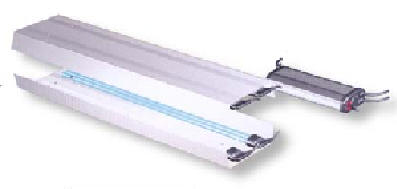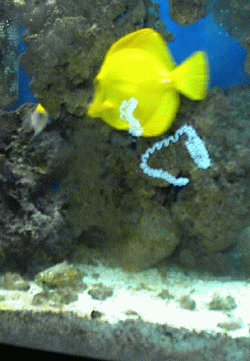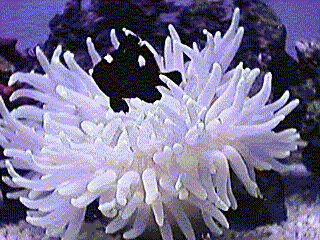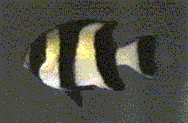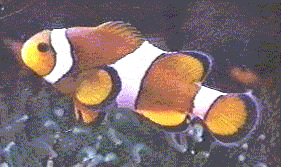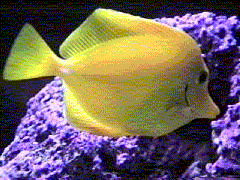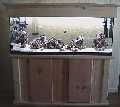Julian and Sarah's Reef Aquarium
Last Updated Monday, January 05, 2004
Tank
|
Fish
|
||||||||||||||||||||||||||||||||
Lighting HoodJBJ Compact Fluorescent retrofit kit, equipped with one 65W actinic, one 65W cool white, one 55W actinic and one 55W cool white (various manufacturers). |
Other Animals
|
Images from January 2004
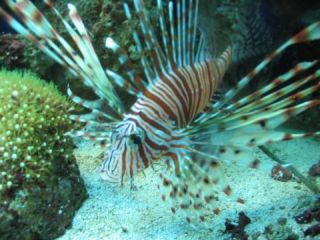
Lionfish
|

Blue veined mushrooms |

Brown polyps |

Candy Cane Coral |

Fungia Coral |

Hammerhead Coral |

Long tentacled Anemone |

Red Mushrooms |

Squamosa Clam |

Unknown ??? |

Unknown ??? (porites?) |

Unknown ??? |
Images from January 2003
|
|
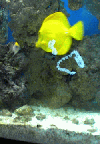 |
Timeline (from December 2001)
![]()
The following describes the original aquarium, which was set up in June 1999 and dismantled in March 2001 because we moved house ....
Tank
|
Fish
|
||||||||||||||||||||||||||||||||||||||||||
Lighting Hood
|
Other Animals (identified and unidentified)
|
||||||||||||||||||||||||||||||||||||||||||
Equipment
|
|
||||||||||||||||||||||||||||||||||||||||||
Timeline
| Date | Activity | Comments | Picture |
| June 6, 1999 | Tank purchased. Substrate washed and added to tank. Tank filled with salt water. Conditioned with Seachem Prime. Hagen Cycle added. Heater installed, Powerhead 402 installed. Single F40T12 light installed | Why do these bags of substrate always say "pre-washed" and yet they need about 1/2 hour of continuous washing in running water before the cloudiness disappears?! | |
| June 7, 1999 | SeaClone Skimmer installed | This is a venturi counter-current device. Seems more efficient than the VisiJet I installed on my reef aquarium in France | |
| June 13, 1999 | Uncured Fiji Live Rock arrives from Flying Fish Express. Dipped in saltwater and added to tank. | The Live Rock is very different from some Indonesian I bought in Switzerland years ago ... the Fiji rock has no snails or crabs or other critters like that, but it does have much more attractive coralline algae on it ... | |
| June 15, 1999 | Hood equipped with electronic ballast and tubes. | Electronic ballast and end caps purchased at Home Depot. Very simple installation. Still requires a reflective layer of some sort to be attached on the underside of the hood, above the tubes .... | |
| June 19, 1999 | Four damsels added. | The fish seem to enjoy the tank. A peanut worm is spotted hanging half out of a piece of live rock. |
|
| June 23, 1999 | Status | Much hassling in the tank between the two yellow-tailed damsels. There are many clumps of purple coralline algae growing on the lice rock. Lighting is currently two F32T8 cool white and one F40T12 blue actinic. |
|
| June 24, 1999 | One yellow-tailed damsel added, plus one large Hermit crab and two smaller Hermit crabs. | The extra damsel was added in an attempt to calm down the existing two. However, the fracas continues. |
 |
| June 27, 1999 | Large piece of coralline live rock added | ||
| July 5, 1999 | One Boxfish and one Sebae Anemone added | Damsel fracas seems to have ended. Anemone very difficult to place, even with powerheads turned off: it tends to "swim" around the aquarium randomly! SG 1.0215, NH4 <0.25 ppm, T 82F | |
| July 7, 1999 | DISASTER | Boxfish found with snout up the the powerhead intake: dead. Only remaining
fish alive in tank is one of the striped damsels: the rest have been killed, probably by
the toxin which is reportedly produced by the Boxfish. There has clearly been a "spurt" of activity in the protein skimmer... enough to blow the top off the collection cup! Dead fish removed. Start filtering with activated charcoal granules. |
|
| July 23, 1999 | One chocolate chip starfish, one red starfish and three domino damsels added. | These are the first living things added to the tank after the disaster on
July 7. Lighting is currently three F32T8 cool white, and one F40T12 blue actinic. |
 |
| July 27, 1999 | CleanUp Crew (from Flying Fish Express) added, plus one False Gramma and one finger leather coral. |
 |
|
| July 31, 1999 | One Yellow Tang added | Water slightly cloudy so adding activated charcoal in a cannister to the tank, attached to powerhead intake. | |
| August 14, 1999 | One cleaner shrimp added | Some very small black dots have appeared on the Tang. |
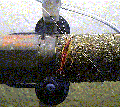 |
| September 12, 1999 | Two Percula Clowns added | Most of the turbo snails have died and been eaten by the chocolate chip starfish. There are four left. | |
| October 20, 1999 | Sebae Anemone shrank, hid, then disappeared: probably eaten | ||
| October 31, 1999 | Finger leather coral dead | Probably insufficient light | |
| November 1, 1999 | Installed 150W compact fluorescent | Light from this is "warm", and predominantly yellow: probably not ideal | |
| November 7, 1999 | One Hawaiin Feather Duster added One Bubble Anemone added |
||
| March, 2001 | Tank broken down | Moving House. See above for Sarah & Julian's new Reef setup |
Several people have suggested what the mysterious disks might be:
| From: "Martin Miller" <mmiller@mcmail.com> Could be disk worm. If they are, the only problem with them is they can choke coral to death. The best way I konw to get rid of disk worm is a Mandarin, they love them. Martin | |
| From: ahartplus4@aol.com (Ahartplus4) I have these in my tank also. My tassled filefish eats them sometimes but my friend has a China Wrasse that made short work of the many in his tank. Just a thought... Alice | |
| From: Edith Hedges <cferh@eiu.edu> I have something like that in my system and it seems to be giving the hard corals some problems. If you chase it off the glass and it swims in a unulating fashion I would guess that it may be a nudibranch. If they are like my little critters they reproduce.......rapidly. Solution:???Maybe a small Wrasse. Frank | |
| From: nanoreef1@aol.com (Nanoreef1) This ones new to me. They could be sand dollars. Which if you have a thin sand layer in your tank will be quite beneficial. But to be sure ask a Klingon. | |
| From: nullman@hotmail.com (Nullman) Hey, I have a few of those in my reef too! I seem to remember having quite a few when I first set up my tank, then didn't see any more for months. This weekend I saw two of those! freaky.... No, I have no idea what they are. I didn't even think they were alive until the next day they were both in different places. Mike | |
| From: "KaboomMn" <kaboommn@gateway.net> Julian; I had Charles Delbeek look at your photo to see if he had any thoughts as to what it may be. He thought it could be a rather pale_ Acetularian sp._, which is a type of algae. I blew up your photo in PhotoShop5 for a better look and then viewed a number of pics. of various Actel. and I don't think that's what it is. I also thought it was some type of algae and maybe it still is. Chuck also thought that it may be a Foraminfera, which is an amebic animal, with a calcium carbonate test (shell ). I remember these things from Invert. Paleontology and I know some get quite large. I check all of my books and found one that deals with the Meio-Fauna and to my surprise there was a diagram of a species that very closely resembles yours and gets even a little larger. I'm not saying that is it, just some thoughts. -- Boomer | |
|
From: Alan Monroe [monroe@cpinternet.com]
Looks like a chiton (Kiton)...I'm unsure of the spelling ... but there sort of snail like but they never move ...sort of like barnacles
Mark
|
Some online fishy stores:
